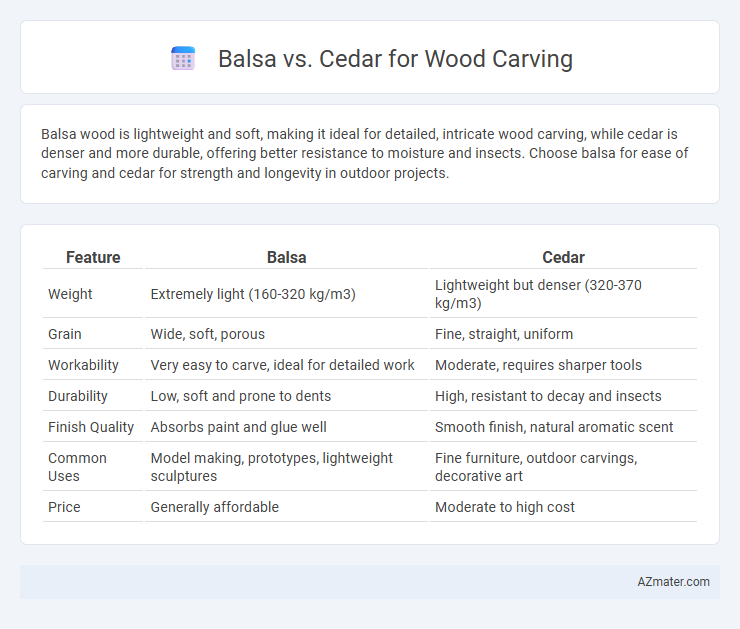Balsa wood is lightweight and soft, making it ideal for detailed, intricate wood carving, while cedar is denser and more durable, offering better resistance to moisture and insects. Choose balsa for ease of carving and cedar for strength and longevity in outdoor projects.
Table of Comparison
| Feature | Balsa | Cedar |
|---|---|---|
| Weight | Extremely light (160-320 kg/m3) | Lightweight but denser (320-370 kg/m3) |
| Grain | Wide, soft, porous | Fine, straight, uniform |
| Workability | Very easy to carve, ideal for detailed work | Moderate, requires sharper tools |
| Durability | Low, soft and prone to dents | High, resistant to decay and insects |
| Finish Quality | Absorbs paint and glue well | Smooth finish, natural aromatic scent |
| Common Uses | Model making, prototypes, lightweight sculptures | Fine furniture, outdoor carvings, decorative art |
| Price | Generally affordable | Moderate to high cost |
Introduction: Balsa vs Cedar for Wood Carving
Balsa and cedar wood differ significantly in density and workability, which greatly impacts their suitability for wood carving. Balsa is an exceptionally lightweight, soft wood that allows for easy cutting and detailed carving, making it ideal for beginners and intricate projects. In contrast, cedar is denser and more durable, offering a fine grain that holds detail well but requires sharper tools and more effort to carve, favored by experienced carvers seeking longevity in their work.
Overview of Balsa Wood Properties
Balsa wood is renowned for its exceptional lightness, with a density ranging from 100 to 200 kg/m3, making it significantly lighter than cedar. Its softness and fine grain structure allow for easy cutting and shaping, ideal for intricate wood carving projects requiring precision and minimal tool wear. Balsa's low strength and moderate durability necessitate careful handling, but its excellent workability and smooth finish make it a preferred choice for model makers and detailed carvings.
Overview of Cedar Wood Properties
Cedar wood features a fine, straight grain with a smooth texture, making it ideal for detailed wood carving projects. Its moderate hardness offers durability while remaining easy to carve, and its natural oils provide resistance to rot and insect damage. The aromatic scent of cedar adds a pleasant fragrance, enhancing the overall appeal of the finished carved piece.
Workability: Carving Ease Comparison
Balsa wood is significantly softer and lighter than cedar, making it easier to carve for beginners and detailed projects due to its low density and smooth grain. Cedar, while still workable, has a firmer texture and more pronounced grain, which requires sharper tools and more effort but offers better durability and finer detail retention. Choosing between balsa and cedar wood depends on the desired balance between carving ease and the final product's strength and texture.
Durability and Strength Differences
Balsa wood is lightweight and soft, making it easier to carve but less durable and strong compared to cedar. Cedar offers greater strength and resistance to wear, ideal for detailed carvings that require longevity. The denser grain of cedar provides better structural integrity, while balsa's fragility limits its use to prototypes or less demanding projects.
Weight and Density Considerations
Balsa wood is significantly lighter than cedar, with a density ranging from 100 to 200 kg/m3, making it ideal for delicate, lightweight carvings requiring ease of handling and minimal tool resistance. Cedar, with a higher density between 320 to 480 kg/m3, offers greater durability and a firmer texture, suitable for detailed work but demanding more effort during carving. The weight-to-strength ratio favors balsa for models and prototypes, while cedar provides enhanced structural integrity in finished wood carving projects.
Grain Structure and Aesthetic Appeal
Balsa wood features a coarse, open grain structure that allows for easy carving and rapid shaping, making it ideal for beginners and lightweight projects. Cedar has a tighter, more uniform grain that provides durability and a smooth finish, favored for detailed and intricate wood carving. Aesthetically, cedar offers a warm, rich color with natural aromatic qualities, while balsa presents a pale, neutral tone perfect for painting and decorative finishes.
Suitability for Detailed Carving
Balsa wood is highly suitable for detailed carving due to its extremely soft and lightweight nature, allowing for precise cuts and fine detailing with minimal effort. Cedar, while aromatic and moderately soft, is denser and has a more pronounced grain, which can make intricate carving more challenging and less smooth compared to balsa. For artists prioritizing delicate and detailed work, balsa's ease of shaping and smooth texture offers superior control over fine sculptural elements.
Cost and Availability of Balsa and Cedar
Balsa wood is significantly more affordable than cedar, making it a popular choice for budget-conscious wood carvers. Its widespread availability in pre-cut blocks and sheets enhances convenience for hobbyists and professionals alike. Cedar, while more expensive, is less commonly found in carving-specific sizes but valued for its durability and aromatic qualities.
Best Applications for Each Wood Type
Balsa wood, known for its ultra-lightweight and softness, is best suited for intricate carving projects like model making, prototypes, and delicate sculptures where ease of shaping is essential. Cedar offers moderate hardness with natural oils that resist decay and insects, making it ideal for outdoor carvings, furniture accents, and architectural details requiring durability and weather resistance. Choosing between Balsa and Cedar depends on whether the project prioritizes lightweight, fine detail work or longevity and structural integrity in exposed environments.

Infographic: Balsa vs Cedar for Wood Carving
 azmater.com
azmater.com